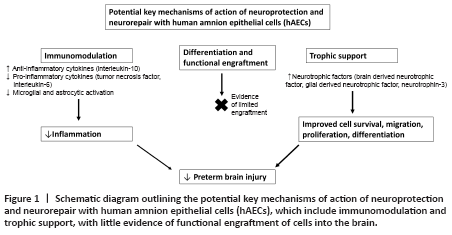神经损伤与修复
-
Figure 1|Schematic diagram outlining the potential key mechanisms of action of neuroprotection and neurorepair with human amnion epithelial cells (hAECs), which include immunomodulation and trophic support, with little evidence of functional engraftment of cells into the brain.

hAECs offer a number of practical advantages (Bennet et al., 2018; Yates et al., 2021). They can be readily harvested from the amnion membranes, which surround the fetus in utero and are discarded at birth, therefore they do not require invasive extraction, making them readily available for rapid treatment in the early postnatal phase. hAECs are pluripotent, are capable of differentiating into cell types of all three germ layers, are non-tumorigenic and non-immunogenic (Bennet et al., 2012). Further, they have significant immunomodulatory properties, including increasing anti-inflammatory cytokines and decreasing pro-inflammatory cytokines as well as increasing the release of neurotrophic factors including brain derived neurotrophic factor, glial derived neurotrophic factor and neurotrophin-3, making them ideal as a generic pan-therapy (Bennet et al., 2012) (Figure 1).